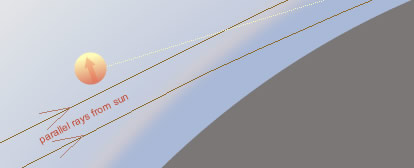
OPOD
What's New
Rays & Shadows
Anti-crepuscular
Cloud shadows
Mountain Shadow
Earth's Shadow Blue Sky
Sunsets
Sunset Mirages
Green Flash
Green rim
I-Mir flash
M-Mir flash
Formation
Cloud-top flash
Observing
More Images
Moonrise/set
Opposition effect
Water Droplets
Rainbows
Ice Halos
High Atmosphere
Links & Resources
Search - Index
123456789012345678
| Mock mirages & green flash formation |
|
|||||||||
| Miraging action of a temperature inversion layer. The layer need only be a few feet above the surface (the vertical scale here is exaggerated). Parallel rays from the setting sun follow two paths to the observer above the layer and up to three solar images are seen (the uppermost is erect and for clarity is not shown here). The mirage can greatly magnify small angular differences in ray directions. The separation between red and green images is enhanced and can give a green flash. |
| |
As the sun sinks its rays start to pass through the temperature inversion. The action of the inversion is most easily understood by concentrating on the interface between the warmer layer and the cool more dense air beneath. Rays passing downwards through it are refracted so that they curve* slightly towards the earth. The upper parallel sun ray glances through the inversion and is most strongly curved. To the eye, the ray appears to be coming from a point higher in the sky and it contributes to an upper (and inverted) image of the sun. The lower parallel ray is less deflected and contributes to a lower solar image. In a direction tangential to the base of the inversion layer small vertical differences in ray directions are highly magnified. The normally insignificant green rim of the sun is vertically stretched to produce a green flash. When the inversion layer, as shown here, is at constant height the mirage effects are all below the astronomical** horizon. Sometimes inversion layers follow vertical atmospheric waves, the mirage and green flash can then appear rather higher in the sky as in the example here. See Andrew Young's pages for further explanation and a simulation. |
* |
Ray curvature. Sometimes the inversion can be sufficiently strong that the ray curvature equals or is stronger than that of the earth. The rays are then guided along the inversion layer - a duct. Ducting can make objects at a considerable distance below the horizon visible. |
** |
The astronomical horizon is defined by a horizontal plane passing through your eye. When you are even a small distance above sea level the real horizon is always below the astronomical one. From an aircraft the real horizon is obviously lower. Pure I-Mir and M-Mir flashes always occur below the astronomical horizon which is why a clear horizon, and preferably a sea horizon, is needed. |



